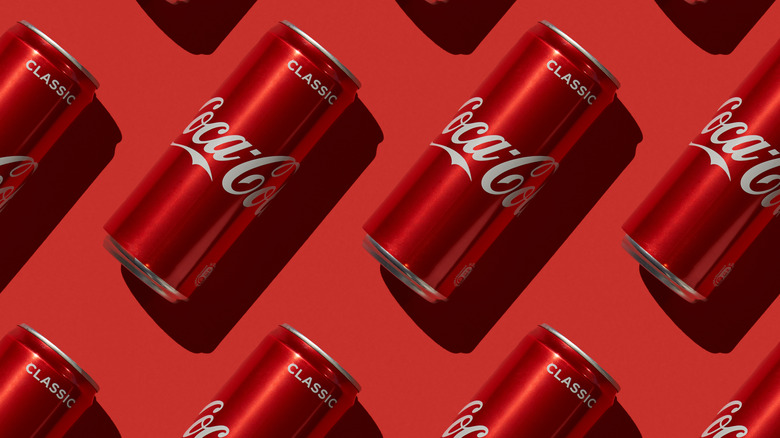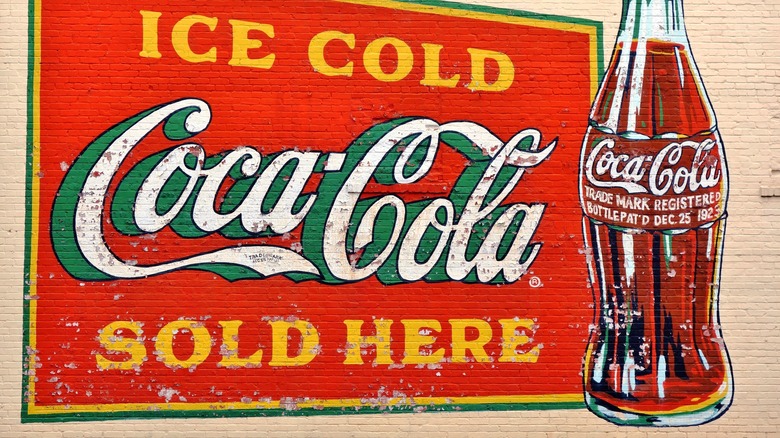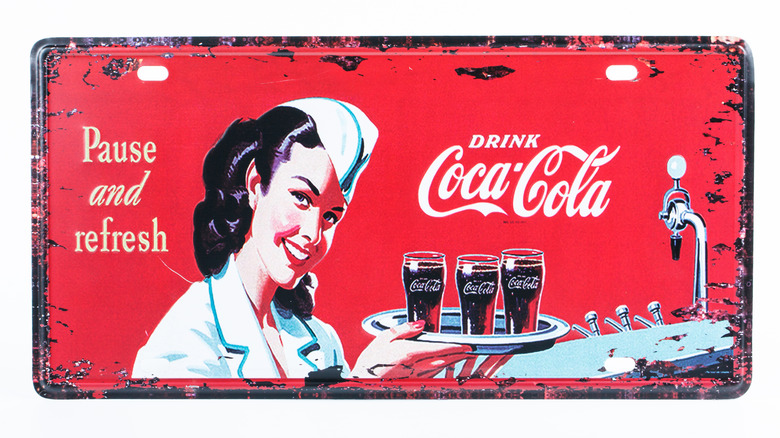Coca-Cola Cans Were First Created Out Of A Wartime Necessity
Coca-Cola was not the first soda (that title goes to fizzy lemonade), and it's not even the oldest American soda company (hello, Dr. Pepper), but the brand exercises a clear-cut dominance over the soft drink world. Regular Coke is the most popular soda in the country, according to Newsweek, with Diet Coke grabbing the number two spot. Each variety tops $35 billion in annual sales, dwarfing third-place Pepsi which comes in at just under $15 billion in sales. Coca-Cola is so ubiquitous that a majority of the American South, from as far west as New Mexico all the way east to the Carolinas, uses "coke" as a synonym for soda, no matter what variety they're talking about (via Insider).
There is a great deal of lore surrounding Coca-Cola, from the famed secrecy of its formula to the fact that it originally contained real cocaine. Coca-Cola has also achieved special status as a cultural symbol of the United States, something that truly came to prominence during World War II. In his book, "For God, Country, and Coca-Cola," author Mark Pendergrast quotes a Japanese radio broadcast that declared, "With Coca-Cola, we imported the germs of the disease of American society. These germs, however, were introduced in such a pleasant way that we failed to realize it."
As it were, the wars of the mid-1900s did more than raise Coke's international profile; they also brought us the Coca-Cola can.
Before Coke was canned
Coca-Cola was invented in 1886, and for the first eight years of its existence, it could only be purchased at soda fountains. According to History, it wasn't until 1894 that you could even buy Coca-Cola in a bottle because company president Asa Candler was convinced that bottling would make no difference in revenue. He was so steadfast in this conviction that he sold the bottling rights to a pair of Tennessee businessmen for the total sum of one dollar.
Candler was, of course, wrong in his assumption, and eventually, the bottlers decided that they should have a distinct container that would distinguish their brand from others. In 1915, they settled on the iconic shape of the Coke bottle that we still know today. While the effort to get Coke into bottles was hampered by stubbornness, the effort to get it into cans faced more objective obstacles. According to the Can Manufacturers Institute, efforts to can carbonated beverages began around 1930.
Metal containers were appealing because they would be less fragile to transport than glass, but there were concerns that the material would not be able to hold up against the pressure of the fizzy contents. Another problem was the fact that the first cans were made from tin and iron, both of which could be corroded by acidic sodas. A solution was found in the form of organic linings to shield the metal, and in 1938, Cliquot Club ginger ale became the first soda sold in a can.
The troops demand Coke
The Coca-Cola Company saw the same appeal in cans that other soda makers did, namely the fact that they were easier to transport than bottles. This fact became all the more appealing during World War II when troops overseas found themselves craving a taste of home.
Coca-Cola reports that the demand for its product among Allied soldiers was so significant that General Dwight Eisenhower sent a cablegram to the brand's Georgia headquarters in 1943, requesting the shipment of enough materials to build 10 Coca-Cola plants. Ultimately, 64 plants would be built abroad during the war, but back home, the company had been experimenting with canning their drinks, which would surely be a lot easier than shipping out the parts for entire factories.
Notably, the war provided the motivation for putting Coke in cans, but it also gave the company a serious obstacle. The folks at Coca-Cola designed a can, but they were unable to manufacture it in bulk because metal was being rationed for the war effort. According to Collectible Soda Cans, production of canned Coke didn't actually begin until 1955, and, fittingly, it found its first test market in American troops stationed overseas. The original cans were inscribed "Prepared for export only," and they've become a rare collectible.
In 1960, Coca-Cola cans were finally released to the general public, with one interesting trait. Per Insider, the first commercially-sold cans bore the image of a glass Coca-Cola bottle, just in case you were confused about what lay inside.


